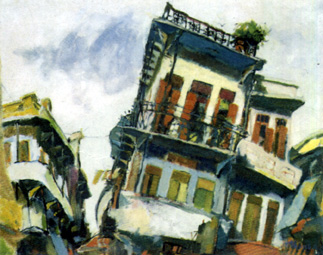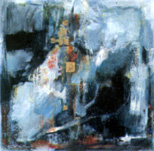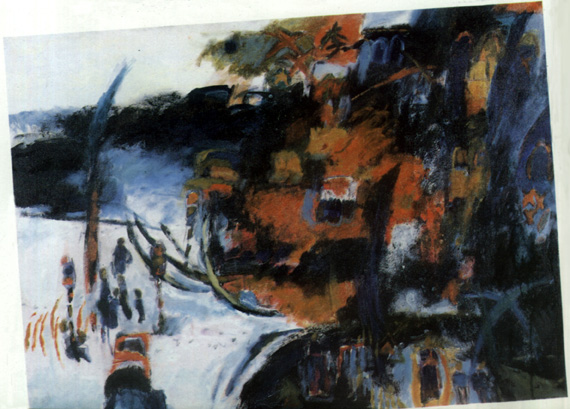The 19th century painter Courbet said: "I paint what I see, I cannot paint what I do not see". This shows that before the 20th century, painters limited themselves in the search for the forms of objects and that this search had become their concept of art.
In our times, artists are trying to uncover their inner-most feelings, and the time they live in including even the most evil desires. In the present century, horizons have been expanded in the field of art, and different views are to be seen; one may see Surrealism explore dreams and the subconcious; Expressionism abstracts the frustration of the artist; Conceptualists open up to thoughts, to the psyche of the genes.
The public cannot but accept this new attitude. The general public hardly believe their own eyes when they first see Fauvism, Cubism or Dadaism, but as time goes by, observers have started to acknowledge and accept the reality of these works which refer to ourselves, and the soul of the shattered era in which we live.
The exhibition by Kwok Woon and Ung Vai Meng belongs in the field of modern art.
Kwok Woon uses imagination to splash colours onto the canvas. Contrasting markings and forms, harmony is constructed on its surface. Sometimes there is agitation, and some times there is cool aspiration. The painter moves entirely into his painting.
 "Leaning"-oils(92cm x 74cm) - Ung Vai Meng
"Leaning"-oils(92cm x 74cm) - Ung Vai Meng
 "Moments of Glory II"-oils (77cm x 77cm)-Kwok Woon
"Moments of Glory II"-oils (77cm x 77cm)-Kwok Woon
Kwok Woon reminds me of De Kooning, but his works are more docile than those of De Kooning. There are beautiful bodies, love, feelings of joy, filled with imagination and metaphor. The sense of surrealism is definitely there.
One of his paintings, "Desire', explains it all. Several strongly textured colours are mixed together as if by a woman's hand. Kwok Woon has lived in South-East Asia, he is pure and straightforward, endowed with all the sentiments of a man of our time. It is all there in the painting.
His drawings always reflect his talent. Different layers of transparent colours define the artist in his way of transpiring the underlying. Clearly, traditional Chinese culture flows in his veins, everything seems to be so sincere.
Ung Vai Meng is a good artist with potential. With lines and colours he is searching for his world, there is no artistic pretext, whatsoever, just the concept of himself. Kandinsky said: "When the question of form is concerned, it all depends upon the immanent desire of the artist'. Therefore, when I come to appreciate his work, enthusiasm and hope are included in my acknowledgement of the artist.
"Whiteness" is an extraordinary painting. Its beauty is naturally expressed through evolving forms and colours filled with intention. Ung Vai applies layers of a white which become progressively purer, so as to attain a painting that is bursting with life and sincerity.
Another painting, "Without Title", uses tracks of lines, breaking up the structure, black lines spreading out, moving according to an organized rhythm. This is a very characteristic painting.
Ung Vai Meng is very young. His rhythm is easily transcribed into the rhythm of his time. The forms of reality are reproduced, and his sincerety leaves no trace of mystification in his paintings, thus his world is easily recognizable. Painting is a difficult job. This exhibition permits us to hear the innocent heart-beat of the artists.
Kwok Woon
•1942: Born in Guangdong and is educated at the Shanto School of Art. His work is selected for a national art exhibition. • 1962: Moves to Hong Kong where he becomes a professional artist and carries out resarch onmodern eastern and western art styles. He joins the Hong Kong Artists' Club and the Guangdong Academy of Art Alumni Association. His paintings are exhibited in Europe and America and he visits Macau regularly. •1963: Participates in a collective exhibition of Hong Kong artists given in Taiwan • 1967: Participates in the "Ten Friends" art exhibition in Hong Kong. • 1969: Solo exhibitions in Singapore and Malaysia. • 1979: Joins the Association of Fine Arts of Macau. •1980: He moves to Macau where he joins the Artists and Calligraphers Association of Macau/ Yi Yuan and takes part in several collective exhibitions. • 1984: Collective exhibition "Macau Artists" in Oporto's Crystal Palace. • 1985: lst Exhibition of "Macau's Artists" sponsored by the Leal Senado. • 1986: Solo exhibition of his abstract paintings. Exhibits in Estoril, Portugal. • 1987: Solo exhibition in Macau. Exhibits in the "9 Artists" exhibition. Founding member of the Contemporary Art Group in Macau. • 1988: Gives a joint exhibition with Ung Vai Meng sponsored by the Leal Senado
Ung Vai Meng
• 1958: Born in Macau and, under the influence of his brother, becomes interested in art at an early age. • 1975: Begins studying drawing and watercolour with Master Kam Cheong Lang. Joins the Association of Fine Arts of Macau and takes part in many exhibitions. • 1981: Collective exhibition given in Macau. • 1983: Joins the Graphics Department in the Cultural Institute of Macau. • 1984: Solo exhibiton "Drawings of Lisbon" held in Macau. • 1985: Solo exhibition "Drawings by Ung Vai Meng" and gains increasing recognition for his artwork in the Cultural Institute of Macau. • 1986: Awarded a scholarship by the Cultural Institute to study painting and screen-printing in the Institute of Fine Arts in Oporto. The Cultural Institute prints twelve of his paintings of Macau's architectural heritage as a collection of postcards. • 1987: Starts working as an illustrator for the Review of Culture. Founding member of the Contemporary Art Group in Macau. Exhibits in the "9 Artists" exhibition. • 1988: Gives a joint exhibition with Kwok Woon sponsored by the Leal Senado.

"Movement"-oils (122cm x 91cm)-Ung Vai Meng
start p. 47
end p.